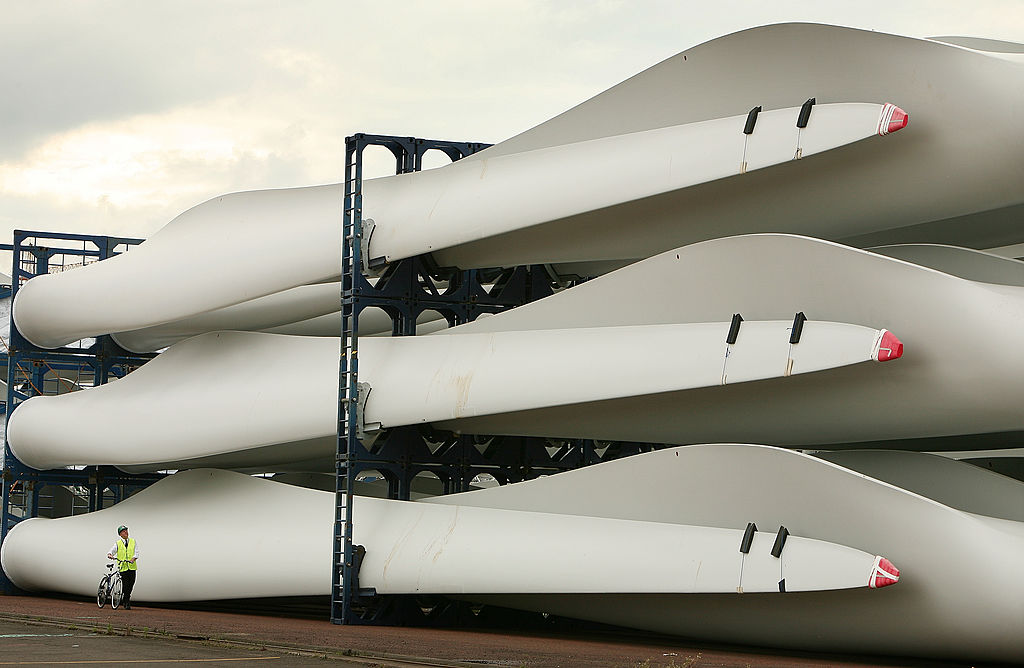This spring, researchers at a quarry near Draperstown, Northern Ireland, undertook what amounted to a massively scaled up version of the type of science experiment you might see in a middle school classroom. Using a crane, researchers added huge concrete blocks—each 2,400 lbs.—to a footbridge to see how much weight it could hold. What was notable about the bridge, though, was that instead of using steel or timber girders, the bridge made use of two 23-foot lengths of decommissioned wind turbine blades for its supports. And instead of holding six blocks, as the researchers expected, the bridge held 33 of them, around 80,000 lbs., and still did not fail.
Figuring out what to do with used wind turbine blades is a weak point in the rollout of renewable energy. About 85-90% of the components of most wind turbines—including the steel tower, the gears and generator assembly, and the concrete base—can be recycled. But the blades, intended to be strong enough to withstand hurricane-force winds and light enough to swing in the breeze, are typically made out of materials like fiberglass that are much harder to break down and reuse after the wind turbine has reached its end of life. A lot of them are ending up in industrial incinerators, or buried in landfills. “The wind turbine blade will be there, ultimately, forever,” Bob Cappadona, chief operating officer for French water, waste, and energy company Veolia Environnement SA’s North American branch, told Bloomberg in 2020. “The last thing we want to do is create even more environmental challenges.”
Wind turbines are one of the safest and most cost effective ways to generate electricity without the use of fossil fuels. If the world is to reach net-zero emissions and avert catastrophic climate change, they’re going to play a big part. That will also entail solving the problem of what to do with used turbines when they wear out (the blades usually last about 25 years). The Re-Wind Network, the international effort of researchers and entrepreneurs dedicated to finding uses for old turbine blades, and the group behind the bridge experiment, estimates that the world is going to be dealing with about 8.6 million tons of scrapped wind turbine blades by 2042.
That’s an issue, though it’s important to keep things in perspective; 8.6 million metric tons of world wind waste is a lot, but it’s also a drop in the bucket compared to the 265 million metric tons of trash that the United States alone produces every year. Still, the image of today’s clean energy becoming tomorrow’s landfill isn’t exactly a publicity coup for renewable energy. And as long as the world is trying to roll out green energy, it seems that it would make sense for that energy to be truly renewable.
Founded in 2018, Re-Wind among other groups has been experimenting with ways to put leftover wind turbine blades to use. Pedestrian bridges are one idea: the group has built one bridge in Northern Ireland and another in the Republic of Ireland, with a third planned in the U.S. in Atlanta, Ga. Other projects have seen old wind turbine blades transformed into playground equipment and shelters for storing bicycles.
It’s difficult to imagine those uses taking care of more than a handful of turbine blades at a time, though. “The amount of blades coming to their end of life is going to be phenomenal over the next 20 to 30 years,” says Jennifer McKinley, a professor of geography at Queen's University Belfast who helped lead the Draperstown project. “We need solutions that are actually going to use quite a few of them, rather than just one or two here or there.”
But using a lot of them at once is easier said than done. One company, Global Fiberglass Solutions, launched in 2009 with the goal of building a business recycling fiberglass like that used in turbine blades into new construction materials. “We create a circular, zero-waste solution to bypass landfilling of fiberglass waste and to reduce the world’s carbon footprint,” the company wrote on its LinkedIn page. Back in 2020, Don Lilly, the company’s CEO, said his firm was “gearing up” to recycle huge numbers of wind turbine blades when orders from builders started coming in, according to Bloomberg. Yet the company’s plans appear to be progressing very slowly, much to the chagrin of residents living near the company’s blade stockpiles. As of last month, the company had still only processed a handful of blades at its Sweetwater, Tex., location, according to Texas Monthly, while operations in Iowa have been marked by allegations of unpaid rent and clashes with the state’s Department of Natural Resources. (The company did not respond to TIME’s request for comment.)
Other potential solutions to get rid of wind turbine blades include using them for highway noise barriers, or to erect them as utility poles. Those ideas appear promising: Re-Wind members at the Georgia Institute of Technology have even constructed a 20-foot-tall utility pole prototype from a decommissioned blade. One startup, based in Ireland, is attempting to commercialize some of those ideas. McKinley says other positive progress is being made, including with the manufacturers themselves. “Wind turbines and blades are becoming more sustainable,” she says. “For the first generation of wind turbines, [their disposal] was not thought of, but now it is.”
More Must-Reads From TIME
- The 100 Most Influential People of 2024
- How Far Trump Would Go
- Scenes From Pro-Palestinian Encampments Across U.S. Universities
- Saving Seconds Is Better Than Hours
- Why Your Breakfast Should Start with a Vegetable
- 6 Compliments That Land Every Time
- Welcome to the Golden Age of Ryan Gosling
- Want Weekly Recs on What to Watch, Read, and More? Sign Up for Worth Your Time
Write to Alejandro de la Garza at alejandro.delagarza@time.com
